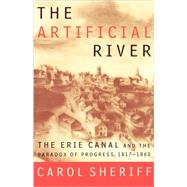The Artificial River The Erie Canal and the Paradox of Progress, 1817-1862
, by Sheriff, Carol- ISBN: 9780809016051 | 0809016052
- Cover: Paperback
- Copyright: 6/12/1997
Winner of Best Manuscript Award from the New York State Historical Association Artificial River reveals the human dimension of the story of the Erie Canal. Carol Sheriff's extensive, innovative archival research shows the varied responses of ordinary people-farmers, businessmen, government officials, tourists, workers-to this major environmental, social, and cultural transformation in the early life of the Republic. Carol Sheriff, a native of Bethesda, Maryland, received her B.A. from Wesleyan University and her Ph.D. from Yale University. She is assistant professor of history at the College of William and Mary. She lives in Williamsburg, Virginia. Winner of the New York State Historical Association Best Manuscript Award The story of the Erie Canalthe 363-mile "artificial river" built to connect the Atlantic seaboard to the Great Lakesoffers a rich perspective on the tumultuous era between the War of 1812 and the Civil War. Completed in 1825 as part of the nation's larger transportation revolution, the Canal opened the Midwest to commerce and settlement, helped make New York City the nation's greatest port, and accelerated the pace of American industrial and economic change. The history of the Canal's impact on the nation's economy has been told skillfully by other historians, and Carol Sheriff considers instead the human dimension of the revolutionary changes that the Canal helped set off: widespread geographic mobility; rapid environmental change; government intervention in economic development; market expansion; the reorganization of work; and moral reform. Among the middle classes, these changes would be grouped together as signs of progress or improvement. With innovative archival research, Sheriff documents the social and cultural responses of men, women, and childrenfarmers, businessman, government officials, tourists, workersto the Erie Canal and the progress it represented. For them, progress meant taking an active role in realizing a divinely sanctioned movement toward the perfectibility of the natural and human worlds. This conception of progress would play a central role in defining Northern sectional identity in the decades leading to the Civil War. "The Artificial Riveris deeply researched, its arguments are both subtle and clear, and it is written with grace and an engagingly light touch. The book merits a wide readership."Paul E. Johnson,The Journal of American History "A beautifully written and unpretentious book that reveals how little historians have known about something they have written so much about: the Erie Canal . . . [The book] becomes a means to follow ordinary American men and womenbusiness people, workers, and farmersas they dramatically rearranged the American landscape and with it, in anticipated and unanticipated ways, American nature."Richard White, Stanford University "[Sheriff] renders the Erie Canal's history from a fresh point of view . . . the everyday lives of ordinary people who lived along the waterway."Paul Grondahl,The Albany Times Union "Broadly conceived, imaginatively researched, incisively argued, and gracefully written. It's a genuine pleasure to learn from Carol Sheriff's outstanding study of culture and class at the very center of early-nineteenth-century America's exploding commercial society."Robert H. Wiebe, Northwestern University "An excellent study of an important, all too often neglected period."Lee Milazzo,The Dallas Morning News "A richly textured, colorful tapestry of social history that weaves together the elements of technology and finance, politics and religious zeal, workers' lives and businessmen's schemes which made up the transforming corridor of the Erie Canal. A







